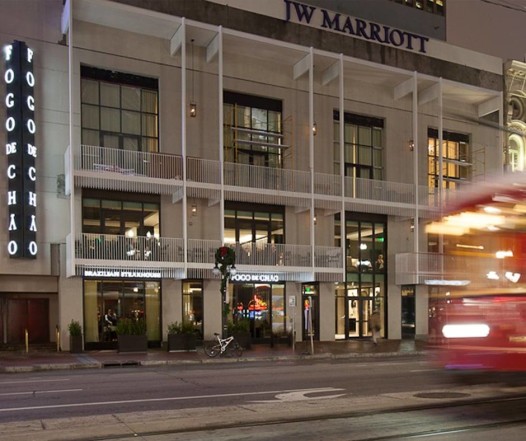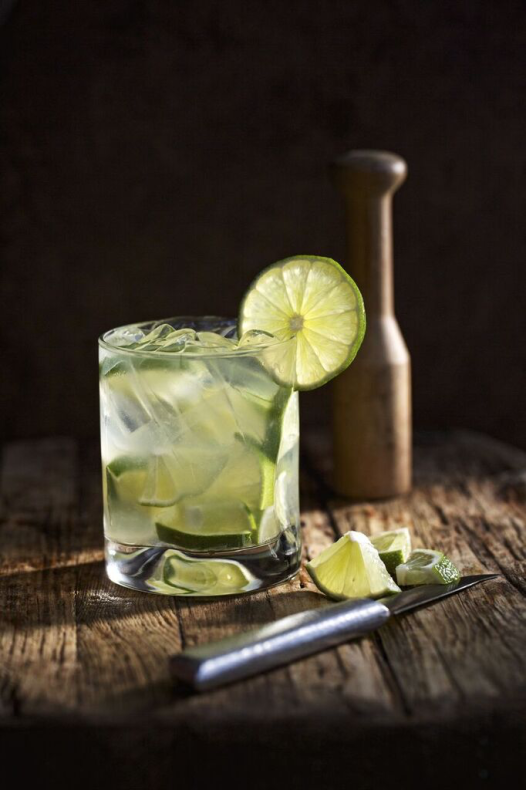
Estrel Do Sul in Rio (Photo: Renee Peck)
On a steamy afternoon in December, I stepped into the boisterous interior of Estrela Do Sul, tucked into the corner of a Rio de Janeiro shopping mall, and discovered the culinary concept of churrasco –roughly the Portuguese equivalent of barbecue. On steroids.
At long wooden tables, diners crowded together amiably, sampling pieces of cheese bread, fried polenta and sautéed bananas, as well as an intricate variety of roasted meats, shaved right off metal skewers tableside. Filets, sausages, parmesan-dusted tenderloins, garlic-studded rump roasts, fish, chicken, pork. The gauchos, wielding their sharp flashing knives, twirled among the chairs, slicing off a morsel here and there as diners snagged the severed tidbits with metal tongs.
It was noisy, entertaining, energetic, and celebratory. This, I thought, would fly in New Orleans.

Newest Fogo de Chao in the J.W. Marriott (Photo: www.facebook.com/fogorestaurants)
And so it is. The Brazilian steakhouse concept got a culinary nudge upward here when Fogo de Chão opened last week in the J.W. Marriott hotel on Canal Street. It has all the requisite churrascaria offerings in a decidedly upscale setting. This is a tablecloth and fine china place, with an airy, contemporary styling courtesy of a hip overhaul by the architects at Eskew+Dumez+Ripple.
But the culinary concept stays true to its Brazilian roots; in fact the name, Fogo de Chão, means “fire on the ground,” a nod to the traditional gaucho method of roasting meats over an open flame.
The restaurant features the requisite central market table, heaped with salads, fruits, cheeses and other auxiliary dishes. But center stage goes to the gauchos, who appear at your table bearing skewers of filet mignon, lamb ribs, sirloin and rib-eyes. As in Brazil, diners are given metal tongs for snagging slices and cardboard coasters, color-coded red on one side, green on the other, to let servers know if they are ready (or not) for more meat.
Fogo de Chão was founded in Brazil in 1979 by two sets of brothers; it has expanded into an international chain that includes more than a dozen U.S. locations. The New Orleans restaurant is the first in Louisiana, and is led by Brazilian-born head gaucho Carlos Girotto. The full meat and market table experience costs $32.95 at lunch, and $49.95 at dinner. Market table fare alone is available for less.

Caipirinha, the Brazilian national drink, plays well in NOLA (Photo: Fogo de Chao)
Whether or not New Orleanians are ready to embrace gaucho cooking remains to be seen. But in Brazil, I was struck by a kindred spirit in its people. Like New Orleanians, Brazilians seem to live in the moment, take the time to celebrate, and embrace life. They, too, have problems stemming from an economic downturn and poverty and crime, and yet there is a joie de vivre that would bring a smile of recognition to any New Orleanian’s face.
There’s one more Brazilian basic that should resonate with New Orleanians: the caipirinha. Brazilians, too, take their cocktails seriously, and this lime-laced national drink made with cachaca (a liquor made from sugarcane) should sit well with the Pimm’s Cup crowd. The Fogo de Chão rendition of the caipirinha is exquisite, made (correctly) with a whole lime per drink. Just don’t try to pronounce it if you have more than one.
Since Rio shares another important tradition with New Orleans – Carnival – it seems only appropriate to sip a caipirinha or two (or three) for Mardi Gras. Here’s how the restaurant does it.
Fogo Signature Caipirinha
1 whole lime
2 tablespoons pure sugar
2 ounces cachaca
 NOLAbeings Multimedia artist Claire Bangser created NOLAbeings as a portrait-based story project that marries...
NOLAbeings Multimedia artist Claire Bangser created NOLAbeings as a portrait-based story project that marries...  Voodoo in New Orleans: Reviving history: New Orleans fortune telling This article takes a deep dive into the history of Voodoo in New Orleans, its hybridization with Catholicism, and its present-day place in the city's culture. The author visits fortune-tellers in the French Quarter, using their guidance as a tool for introspection rather than a deterministic predictor of the future. Through her experiences in New Orleans, the author feels a mystical connection to both the past and the future.
Voodoo in New Orleans: Reviving history: New Orleans fortune telling This article takes a deep dive into the history of Voodoo in New Orleans, its hybridization with Catholicism, and its present-day place in the city's culture. The author visits fortune-tellers in the French Quarter, using their guidance as a tool for introspection rather than a deterministic predictor of the future. Through her experiences in New Orleans, the author feels a mystical connection to both the past and the future. 